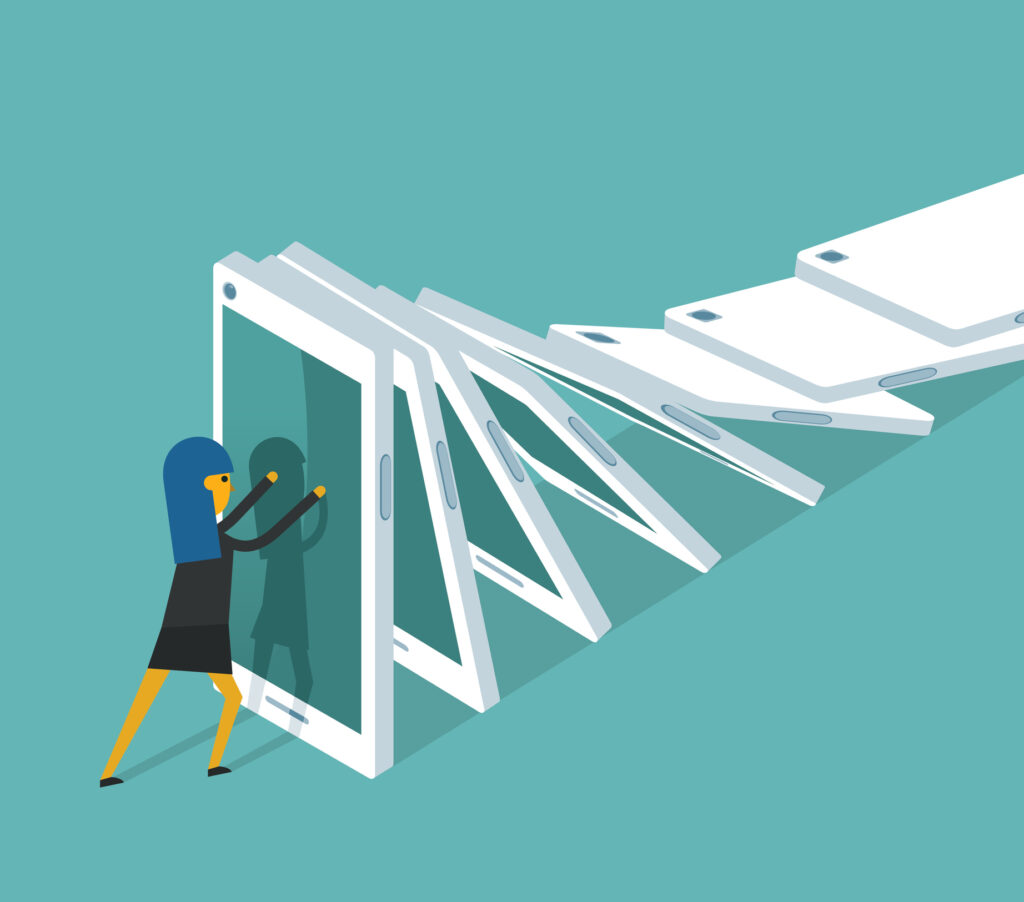There’s no denying that technology has many benefits, but are we ignoring the damage that comes from our reliance on digital devices?
It’s 8.30 in the morning and hundreds of people are crossing London Bridge on their journey to work. Around a fifth of them are looking at their mobile phones as they walk – they’re watching videos or checking emails, yet by carefully dividing their attention they manage to avoid colliding with each other.
Next we have a family of three sat at the dinner table. They’re immersed in their smartphones, each in their own world, whilst the TV sits in the background, switched on but watched only intermittently.
Finally we have a young man sitting on the sofa enjoying a book. He reads a couple of pages before a noise distracts him. It’s a notification on his laptop, telling him a new email has arrived. He pauses, then logs on, only to find it’s spam. He deletes it and resumes his reading.
Many of us routinely use our devices in this fashion, whilst engaged in unrelated activities like walking, standing in a supermarket queue or watching TV – activities which, in an earlier era, would have received our undivided attention.
‘Always on’ is the phrase that has come, for many of us, to define our relationship with mobile devices and these examples illustrate how digital technology has become part of the social fabric.
Technology: friend and foe
This technology brings undeniable benefits. It enables us to keep in touch with family and friends, wherever they are, to shop without leaving the sofa and to stream TV at the time that works best for us. And the work benefits are equally clear – it enables people to work flexibly from anywhere at any time, to use high-quality data to make better decisions and to collaborate remotely with ease.
The result is that most of us are in thrall to digital technology. So much so that UK adults spend an average of 8 hours 41minutes each day in front of screens. A lot of that is on social media, on which the average user spends over two hours a day – a figure that’s increasing.
And the advent of the smartphone has been a game changer. Research from Ofcom this year suggests that on average we check our smartphones every 12 minutes. Our dependence is such that 40% of us check our phones within five minutes of getting up and almost as many do so just before bedtime. In terms of time spent online overall, it’s a huge 25 hours a week for adults in the UK.
Being on permanent alert stimulates the stress response, which is unhealthy and costly for our bodies to maintain for long.
Recent studies have shown just how reliant we’ve become on our devices. In one study 46% of Americans felt that they couldn’t live without their mobile phones. And in the UK 6% of smartphone users suffer from nomophobia, which the Collins English Dictionary defines as “the state of stress caused by having no access to, or being unable to use one’s mobile phone”.
Whilst the advantages of digital technology may be hard to contest, because it’s relatively new, we’ve had little time to monitor its wider effects. But recent research suggests that there may be adverse consequences, particularly for heavy users of digital devices.
And businesses ought to be concerned, because some of these consequences have worrying implications for the performance and productivity of employees when they’re working.
Technology use is detrimental to deep thinking and reflection
One of the key negative impacts is on cognition. The constant stream of new information and alerts we’re subjected to when we’re connected, encourages us to jump from one activity to another and this has led to us developing a state of mind that’s been described as ‘continuous partial attention’.
In this state we’re constantly scoping what’s coming in without giving our full attention to anything. And being on permanent alert like this stimulates the stress response, which is unhealthy and costly for our bodies to maintain for long.
Research has found that being ‘always on’ reduces our capacity for deep thinking and sustained focus. The frequent interruptions we’re subject to when we’re connected eliminate the reflection time we normally have when acquiring new information or ideas.
And when we read online we tend to skim read. Studies have shown that when people read from a screen, their grasp of nuances and understanding of complex information suffers significantly.
Given that in the modern workplace most people access information digitally, the implications are concerning. It may matter little when responding to a routine email but when trying to critique a complex report, a reduction in the quality of our analysis could have critical consequences.
People’s use of technology is affecting both the quality and quantity of sleep they’re getting.
The multitasking myth
In the workplace, we pride ourselves on our capacity to multitask. So much of our work entails sifting and responding to a continuous flow of information.
But neuroscience has found that the brain isn’t really designed to work that way. Changing tasks frequently has been found to reduce productivity by as much as 40%. In one study, people working with the distraction of emails and phone calls saw a 10 point fall in their IQ, which is double that of what was found among people who had smoked marijuana.
And it isn’t just work performance that could suffer. The research is telling us that heavy use of digital media is having a damaging impact on people’s health and wellbeing.
The impact of technology on sleep
Most businesses are now committed to the workplace wellbeing agenda, recognising the links between high levels of wellbeing and strong performance and productivity. So they need to be attending to the wider impact of digital use by their workforce.
For example, good sleep is vital to maintaining physical and mental health, and research over the past 5 years has shown the hefty price businesses pay when employees experience poor quality sleep.
But people’s use of technology is affecting both the quality and quantity of sleep they’re getting. The blue light from mobile devices inhibits the production of the melatonin that we need to sleep, yet so many of us scan the internet or binge-watch TV shows just before bed time.
The result: 47% of us experience a reduction in the amount of sleep we get.
If we can recalibrate our relationships with our digital devices and social media, the potential benefits are significant.
Social addicts
Social media has become ubiquitous across almost all generations. The average person has five social media accounts and these receive heavy usage.
34% of Facebook users will have checked their feed in the last 10 minutes, and incessant scrolling on Facebook has been shown to affect our brain in a similar way to taking cocaine.
There is evidence that some people’s addiction to social media is damaging their closest personal relationships, whilst frequent use of it has been linked to anxiety, depression and poor body image, particularly among younger people.
Time for a digital detox? Or a digital recalibration?
These wellbeing concerns have led some businesses to commission external consultants to run sessions on how to carry out a digital detox.
Requiring a complete break from using all devices, a digital detox can last for anything from a day or a week, to several months. Such breaks are no doubt helpful, but not if you return to the same behaviours once the detox is over.
What is needed is something more sustainable than a detox, something that allows us to continue obtaining the benefits of digital connectedness without the downsides.
If we can recalibrate our relationships with our digital devices and social media, the potential benefits are significant: less stress, improved wellbeing, higher productivity and healthier relationships.
What companies need to be thinking about now is how they can support their employees to attain a healthy balance in their use of these technologies. It would be to everyone’s advantage.






